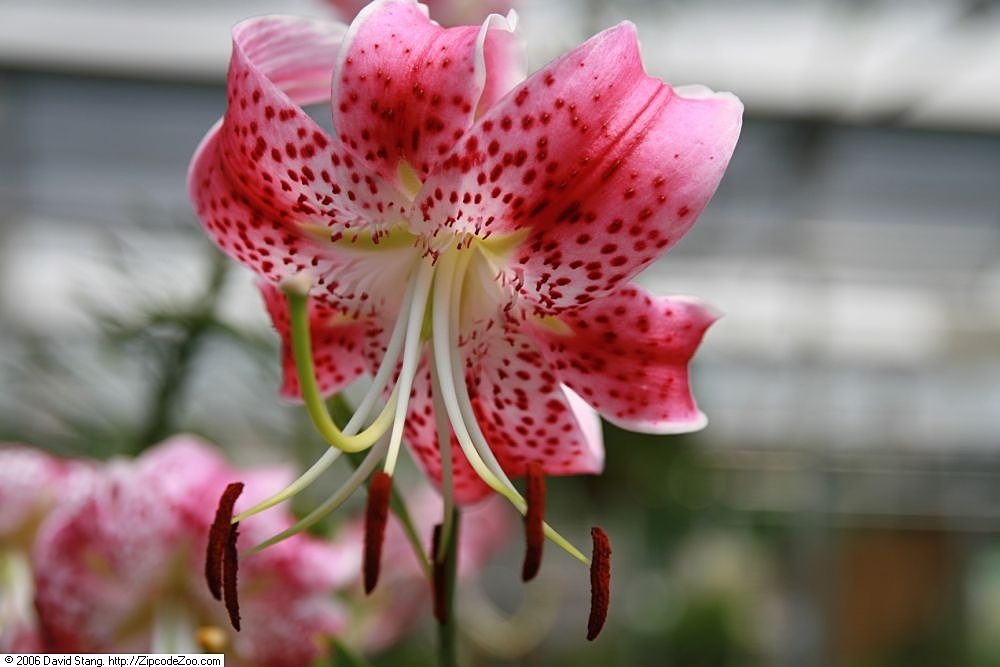Spotted Lily Lilium speciosum
Other Common Name(s):
- Phonetic Spelling
- LIL-ee-um spee-see-OH-sum
- Description
-
The rubrum lily is a perennial bulb in the lily family (Liliaceae). It is native to Japan, Taiwan, and southeast China and found in forests and grassy slopes at 2900 feet elevation. The genus name is Latin for lily, and the species name means spectacular. The rubrum lily was introduced to English gardens in 1830.
This is one of the easiest lilies to grow. It prefers fertile, acidic, well-drained soils and full sun. The soil should be moist and never dry. They can grow up to four feet tall. Space them seven inches apart in groups of three for the best display. The rubrum lily can be divided every three years in the fall. It should be replanted quickly because it does not have a papery cover to help retain moisture like other bulbs. The plant will take four years to bloom if grown from seeds. In warmer areas, the bulbs can be planted in late autumn.
The rubrum lily blooms later than other lilies in late summer and is extremely fragrant. There can be up to 12 flowers on a single stem. Some commercial cosmetics use the flower’s essential oil to mask other scents. The extract of the bulb is used in some skin conditioners. All lilies are toxic to cats from eating the leaf, licking the pollen, or drinking water from a vase with lilies. The roots prefer cool soil so you should plant with annuals to keep the roots shaded. If you prefer perennials, you can plant hellebores or ferns round the base.
Plant the rubrum lily by the patio, walkway, or in a container where you can smell the fragrance. It can be a specimen plant or used in mass planting in open woodlands, cutting, or pollinator gardens.
Insects, Diseases, and Other Plant Problems: It is susceptible to lily beetles, aphids, slugs, Thrips, leatherjackets, wireworms, rabbits, deer, and voles. The stems may need stalking if it is not sheltered against strong winds
VIDEO Created by Elisabeth Meyer for "Edibles, Bulbs, and Houseplants" a plant identification course offered in partnership with Longwood Gardens.
- Profile Video:
- See this plant in the following landscape:
- Cultivars / Varieties:
-
- 'Album'
pure white flowers with white spots. - 'Fourth of July'
thrives in the heat and humidity of the southeast US. Each stalk has 12-14 pendant frilly reddish-pink flowers. - 'Uchida'
Pink and white recurved petals - var. clivorum
Variety native to Japan - var. gloriosoides
Variety found in SE China and Taiwan - var. speciosum
The variety native to Japan
- 'Album'
- 'Album', 'Fourth of July', 'Uchida', var. clivorum, var. gloriosoides, var. speciosum
- Tags:






- Cultivars / Varieties:
-
- 'Album'
pure white flowers with white spots. - 'Fourth of July'
thrives in the heat and humidity of the southeast US. Each stalk has 12-14 pendant frilly reddish-pink flowers. - 'Uchida'
Pink and white recurved petals - var. clivorum
Variety native to Japan - var. gloriosoides
Variety found in SE China and Taiwan - var. speciosum
The variety native to Japan
- 'Album'
- 'Album', 'Fourth of July', 'Uchida', var. clivorum, var. gloriosoides, var. speciosum
- Tags:
-
-
Attributes:
- Genus:
- Lilium
- Species:
- speciosum
- Family:
- Liliaceae
- Life Cycle:
- Bulb
- Recommended Propagation Strategy:
- Division
- Seed
- Country Or Region Of Origin:
- Japan, Taiwan, China Southeast
- Distribution:
- Japan, Taiwan, China Southeast
- Wildlife Value:
- attracts bees, butterflies, and hummingbirds.
- Dimensions:
- Height: 4 ft. 0 in. - 6 ft. 0 in.
- Width: 1 ft. 0 in. - 2 ft. 0 in.
-
-
Whole Plant Traits:
- Plant Type:
- Bulb
- Herbaceous Perennial
- Habit/Form:
- Erect
- Growth Rate:
- Medium
- Maintenance:
- Low
- Texture:
- Medium
-
-
Cultural Conditions:
- Light:
- Full sun (6 or more hours of direct sunlight a day)
- Partial Shade (Direct sunlight only part of the day, 2-6 hours)
- Soil Texture:
- Clay
- Loam (Silt)
- Sand
- Soil pH:
- Acid (<6.0)
- Neutral (6.0-8.0)
- Soil Drainage:
- Good Drainage
- Available Space To Plant:
- Less than 12 inches
- NC Region:
- Coastal
- Mountains
- Piedmont
- USDA Plant Hardiness Zone:
- 5a, 5b, 6a, 6b, 7a, 7b, 8a, 8b
-
-
Fruit:
- Display/Harvest Time:
- Fall
- Fruit Type:
- Capsule
- Fruit Description:
- Three celled capsule
-
-
Flowers:
- Flower Color:
- Green
- Pink
- Red/Burgundy
- White
- Flower Inflorescence:
- Raceme
- Flower Value To Gardener:
- Fragrant
- Showy
- Flower Bloom Time:
- Fall
- Summer
- Flower Shape:
- Trumpet
- Flower Petals:
- 6 petals/rays
- Flower Size:
- > 6 inches
- Flower Description:
- It flowers in late August and September. The nodding flower has white recurved petals with a rose-pink center. The base has blood-red spots with a green stripe. There can be up to 12 fragrant flowers per stem.
-
-
Leaves:
- Leaf Color:
- Green
- Leaf Type:
- Simple
- Leaf Arrangement:
- Alternate
- Leaf Shape:
- Lanceolate
- Leaf Margin:
- Entire
- Hairs Present:
- No
- Leaf Length:
- > 6 inches
- Leaf Description:
- The leaves are scattered along the stem.
-
-
Stem:
- Stem Color:
- Green
- Stem Is Aromatic:
- No
- Stem Description:
- Straight green stems
-
-
Landscape:
- Landscape Location:
- Container
- Patio
- Small Space
- Landscape Theme:
- Butterfly Garden
- Cottage Garden
- Cutting Garden
- Garden for the Blind
- Pollinator Garden
- Design Feature:
- Border
- Mass Planting
- Specimen
- Attracts:
- Bees
- Butterflies
- Problems:
- Problem for Cats









